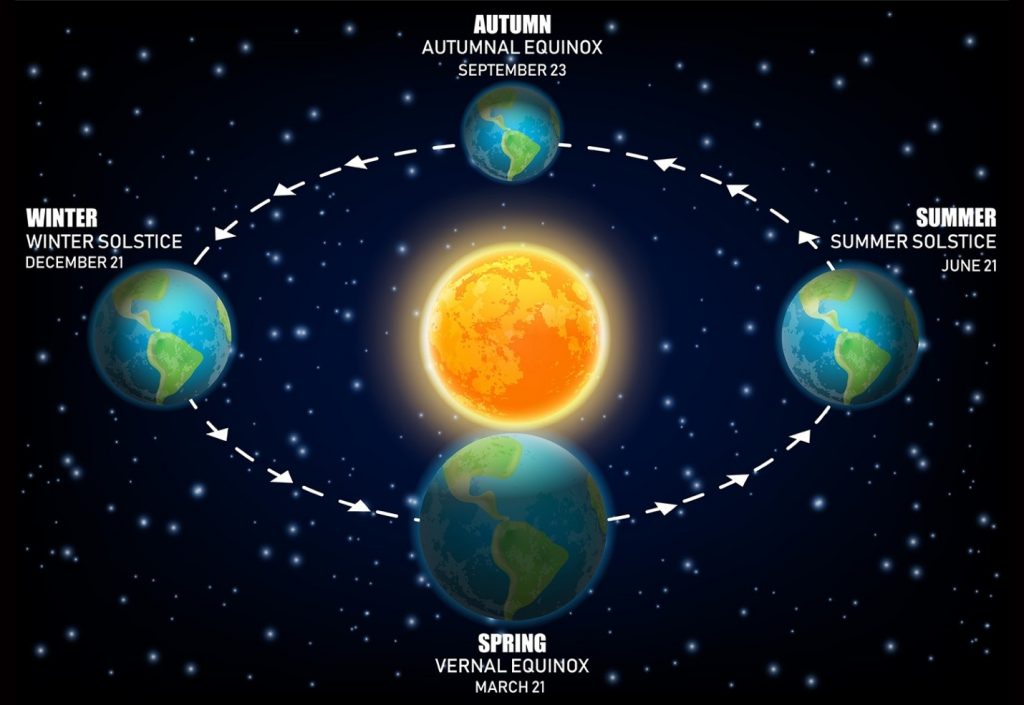The equinox is the event where the point of the lower planet passes through its Equator. Equinoxes are the only time when both the northern and southern hemispheres receive the same amounts of day and night. Worldwide, there are two equinoxes each year: one around March 21 and the other around September 22.
At one time, equinoxes were called “equinox vernal” (spring equinox) and “autumnal equinox” (fall equinox), although these have special dates in the Northern and Southern Hemisphere. The March equinox is the oral equinox in the Northern Hemisphere, and the autumn equinox in the South. The September equinox is an autumn equinox in the Northern Hemisphere and a native of the south.
Science of Equinoxes

During equinoxes, the sun’s angle is 0 °. Sunset refers to the vastness of the Earth when the sun is straight above the sun. (the Equator, of course, is 0 ° latitude.)
Therefore, equinoxes are the only times of the year when the sub solar point is directly in the Equator. The sub solar point is the place where the sun’s rays shine on the earth’s surface – the right angle. Only during the equinox when the Earth’s 23.5 ° axis does not move sideways or away from the sun: the visible center of the Sun’s disk is in the same plane as the Equator.
Before and after the equinox, the sub solar point moves north or south. After the March period, the subversive point moves north as the Northern Hemisphere leans toward the sun. About June 21, a sub solar point hits the Tropic of Cancer, (23.5 ° N). This is the solstice of June, after which the sub solar point begins to move south. After the September equinox, the lower point continues southward as the Southern Hemisphere leans toward the sun. About December 21, the lowlands hit the Tropic of Capricorn (23.5 ° S). This is the solstice of December.
As its name suggests, the equinox shows the illuminated hemispheres, and the solar terminator similarly divides the Earth from north to south. (The solar terminator is a shadowy line that reflects daylight and sunlight around the globe.)
The real equinox will show 12 hours a day and night. Although equinoxes are as close-knit as the Earth, even in equinox times the day and night are not the same. This is mainly due to the reversal of the atmosphere.
Astronomer regression describes how light appears to bend or deviate from a straight line as it passes through the earth’s atmosphere. Atmospheric recurrence is the result of increased airflow, which reduces the speed of light in the air. Thanks to the regeneration of the atmosphere, we can see the sun’s rays before sunrise and sunset.
Equatorial Regions
The Equator, at a distance of 0 °, receives a large amount of solar radiation throughout the year.
As a result, areas around Earth’s Equator receive more sunlight and less equinoctial variation. Equinoxes and rainy seasons often have less impact than weather-driven patterns such as rain (rainy and dry seasons).
Medium Width
Seasonal variation increases in scope. The orbit of the sky also increases the variability in the “equinox” length of day and night. At approximately 30 ° C, the day can be about eight minutes longer than at night.
Polar Regions
The recurrence of the atmosphere is particularly noticeable in the Arctic and Antarctic, with sunlight lasting about 12 hours and 16 minutes. In this way, equinoxes in cold climates show a slight transition from “midnight” to “cold nights.”
“Midnight” refers to the fact that the sun does not set under the sun, keeping the region in the sun 24 hours a day. “Polar Night” means the opposite, a time when the sun does not rise, keeping the region dark for 24 hours.
Equinoctial Disorders
Satellites are in danger of being disrupted in the days before and after the equinox. “End of day” describes this disturbance.
In the Northern Hemisphere, solar eclipses occur just days before the March equinox and after the September equinox. In the Southern Hemisphere, sunrise occurs after the March equinox and before the September equinox.
At the time of the equinox, the sun is directly aligned behind the satellites in the geostationary orbit at the Equator. Located directly above the ground, the satellites are filled with direct sunlight. This solar radiation can disrupt and stop satellites from transmitting signals.
Many communication satellites orbit around the Equator and consumers can find slow Internet connections, static radios, or cold television screens during equinoctial sunrise.
Outer Equinox
Many planets receive equinoxes. The timing of the equinox is determined by the axial inclination of the planet and the orbital signs.
For example, in the Saturn superpower, equinoxes are incredibly remarkable. About 15 years separated the equinox from Saturn, and the equinox lasted about four days.
Saturn’s magnificent ring system orbits the same plane as the equator of the earth. Although the rings extend thousands of miles into space, they are very small, only about a mile wide. During Saturn’s equinox, the rings (and Saturn’s equator) are in perfect harmony with the sun. Images taken with a view of the sun show the rings as a very thin line.
Culture of the Equinoxes
Like solstices, equinoxes are historical symbols of seasonal change.
March Equinox
The March equinox, which illegally marks the spring season, is traditionally considered a time of rebirth and renewal. For this reason, many cultures celebrate the equinox of March as the first day of the new year. The ancient Babylonian calendar began with the first full moon after the March equinox, and today, many cultural and religious calendars continue to celebrate the new year in the spring.